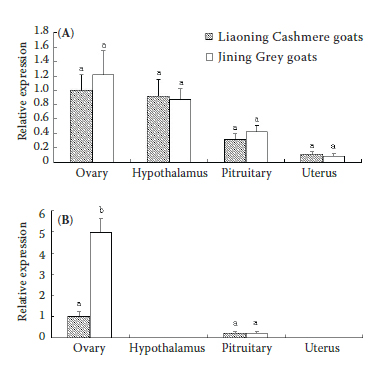分享到
IAS Identified the Tissue-specific mRNA Expression Profiles of GDF9, BMP15, and BMPR1B Genes in Prolific and Non-prolific Goat Breeds
The mutton sheep and goat genetics and breeding team led by Professor Chu Mingxing in Institute of Animal Sciences (IAS) of CAAS, successfully described the tissue-specific mRNA expression profiles of GDF9, BMP15, and BMPR1B genes. The result of this study was published in Czech Journal of Animal Science on October, 2015.
Prolificacy is one of the most important traits in goat and is regulated by some specific genes. Bone morphogenetic protein 15 (BMP15), growth differentiation factor 9 (GDF9), and bone morphogenetic protein receptor, type IB (BMPR1B), known as prolificacy candidate genes, play key roles in regulating ovarian functions in sheep. Spontaneous mutations of BMP15 (FecXI, FecXH, FecXG, FecXB, FecXL, and FecXR) showed that ovulation rate in the heterozygotes was increased, but homozygous mutants were completely sterile in sheep.
The mRNA expression of the genes was detected in prolific Jining Grey goats and non-prolific Liaoning Cashmere goats by reverse transcription polymerase chain reaction (RT-PCR) and quantitative real-time PCR. The results showed that GDF9 and BMPR1B were widely expressed in 20 tissues, while BMP15 gene was expressed exclusively in ovary and pituitary. The expression levels of GDF9 and BMPR1B genes were the highest in ovary. The expression level of BMP15 gene in the ovary of Jining Grey goat was 4.96-fold higher than that in Liaoning Cashmere goat (P < 0.05), but there were no differences (P > 0.05) in the expression level of GDF9 and BMPR1B genes. This is the first study to analyze the tissue expression pattern of GDF9, BMP15, and BMPR1B genes in goat, and the BMP15 might be a major gene for the prolificacy of Jining Grey goat.

Prolificacy is one of the most important traits in goat and is regulated by some specific genes. Bone morphogenetic protein 15 (BMP15), growth differentiation factor 9 (GDF9), and bone morphogenetic protein receptor, type IB (BMPR1B), known as prolificacy candidate genes, play key roles in regulating ovarian functions in sheep. Spontaneous mutations of BMP15 (FecXI, FecXH, FecXG, FecXB, FecXL, and FecXR) showed that ovulation rate in the heterozygotes was increased, but homozygous mutants were completely sterile in sheep.
The mRNA expression of the genes was detected in prolific Jining Grey goats and non-prolific Liaoning Cashmere goats by reverse transcription polymerase chain reaction (RT-PCR) and quantitative real-time PCR. The results showed that GDF9 and BMPR1B were widely expressed in 20 tissues, while BMP15 gene was expressed exclusively in ovary and pituitary. The expression levels of GDF9 and BMPR1B genes were the highest in ovary. The expression level of BMP15 gene in the ovary of Jining Grey goat was 4.96-fold higher than that in Liaoning Cashmere goat (P < 0.05), but there were no differences (P > 0.05) in the expression level of GDF9 and BMPR1B genes. This is the first study to analyze the tissue expression pattern of GDF9, BMP15, and BMPR1B genes in goat, and the BMP15 might be a major gene for the prolificacy of Jining Grey goat.

By Liu Qiuyue
qiuyue1983921@163.com
qiuyue1983921@163.com
Latest News
-
 Apr 18, 2024Opening Ceremony of the Training Workshop on Wheat Head Scab Resistance Breeding and Pest Control in Africa Held in CAAS
Apr 18, 2024Opening Ceremony of the Training Workshop on Wheat Head Scab Resistance Breeding and Pest Control in Africa Held in CAAS -
 Apr 03, 2024IPPCAAS Co-organized the Training Workshop on Management and Application of Biopesticides in Nepal
Apr 03, 2024IPPCAAS Co-organized the Training Workshop on Management and Application of Biopesticides in Nepal -
 Mar 28, 2024Delegation from the School of Agriculture and Food Science of University College Dublin, Ireland Visit to IAS, CAAS
Mar 28, 2024Delegation from the School of Agriculture and Food Science of University College Dublin, Ireland Visit to IAS, CAAS -
 Mar 25, 2024Director of World Food Prize Foundation visited GSCAAS
Mar 25, 2024Director of World Food Prize Foundation visited GSCAAS -
 Mar 20, 2024Institute of Crop Sciences (ICS) and Syngenta Group Global Seeds Advance Collaborative Research in the Seed Industry
Mar 20, 2024Institute of Crop Sciences (ICS) and Syngenta Group Global Seeds Advance Collaborative Research in the Seed Industry
